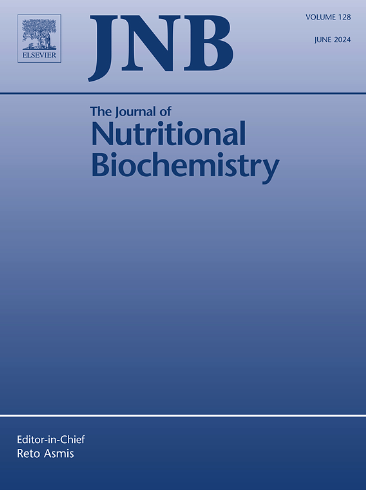β-羟基-β-甲基丁酸盐(HMB)在高脂肪喂养的小鼠中增加肌肉质量并减少体重增加
IF 4.9
2区 医学
Q1 BIOCHEMISTRY & MOLECULAR BIOLOGY
引用次数: 0
摘要
β-羟基-β-甲基丁酸酯(HMB)是亮氨酸的分解代谢物,促进肌肉生长。然而,在高脂肪饮食的背景下,HMB对身体成分的影响知之甚少。我们的目的是研究HMB对体重的昼夜代谢作用。C57BL雄性小鼠分别饲喂任意鼠粮(C)、每1 kg体重添加500 mg Ca-HMB的鼠粮(C+HMB)、高脂饲粮(HFD)或每1 kg体重添加500 mg Ca-HMB的高脂饲粮(HFD+HMB),为期7周。HMB导致HFD+HMB组脂肪重量减少(30%,p < 0.05),体重减少(7%,p < 0.05),肌肉重量增加(17%,p < 0.05)。HMB在C组增加葡萄糖氧化(27%,P<.0001),降低脂肪酸氧化(30%,P<.0001),但在HFD+HMB组增加脂肪酸氧化(10%,P<.05)。在分子水平上,HMB不影响肝脏代谢蛋白,但降低脂肪组织中NF-κB水平(24%,P< 0.05)。在肌肉中,HMB未显示AKT和mTOR的激活,但显示P70S6K (67%, P< 0.01)和S6 (42%, P< 0.01)的激活。P70S6K和S6的激活不依赖于AKT和mTOR,并伴随着磷脂酶D2 (PLD)激活的增加(35%,P< 0.0001)。此外,HMB还会改变昼夜节律。综上所述,喂食HFD补充HMB的小鼠肌肉重量增加,脂肪质量和体重减少,可能是由于运动活动增加。HMB通过PLD2激活P70S6K和S6诱导肌生成。本文章由计算机程序翻译,如有差异,请以英文原文为准。
β-Hydroxy-β-methylbutyrate (HMB) increases muscle mass and diminishes weight gain in high-fat-fed mice
β-Hydroxy-β-methylbutyrate (HMB) is a catabolite of leucine, which promotes muscle growth. However, little is known about the effect of HMB on body composition in the context of a high-fat diet. Our aim was to study the circadian metabolic effect of HMB on body weight. C57BL male mice were fed ad libitum chow diet (C), chow diet supplemented with 500 mg Ca-HMB per 1 kg body weight (C+HMB), a high-fat diet (HFD) or HFD supplemented with 500 mg Ca-HMB per 1 kg body weight (HFD+HMB) for 7 weeks. HMB led to reduced fat weight (30%, P<.05) and body weight (7%, P<.05) and increased muscle weight (17%, P<.05) in the HFD+HMB group. HMB increased glucose oxidation (27%, P<.0001) and reduced fatty acid oxidation (30%, P<.0001) in the C group, but increased fatty acid oxidation in the HFD+HMB group (10%, P<.05). At the molecular level, HMB did not affect metabolic proteins in the liver, but lowered NF-κB levels in adipose tissue (24%, P<.05). In the muscle, HMB showed no activation of AKT and mTOR, but did show activation of P70S6K (67%, P<.01) and S6 (42%, P<.01). The activation of the P70S6K and S6 was independent of AKT and mTOR and was accompanied by increased activation of phospholipase D2 (PLD) (35%, P<.0001). In addition, HMB led to altered circadian rhythms. In conclusion, mice fed a HFD supplemented with HMB have increased muscle weight and reduced fat mass and body weight presumably due to increased locomotor activity. HMB induces myogenesis by activating P70S6K and S6 via PLD2.
求助全文
通过发布文献求助,成功后即可免费获取论文全文。
去求助
来源期刊

Journal of Nutritional Biochemistry
医学-生化与分子生物学
CiteScore
9.50
自引率
3.60%
发文量
237
审稿时长
68 days
期刊介绍:
Devoted to advancements in nutritional sciences, The Journal of Nutritional Biochemistry presents experimental nutrition research as it relates to: biochemistry, molecular biology, toxicology, or physiology.
Rigorous reviews by an international editorial board of distinguished scientists ensure publication of the most current and key research being conducted in nutrition at the cellular, animal and human level. In addition to its monthly features of critical reviews and research articles, The Journal of Nutritional Biochemistry also periodically publishes emerging issues, experimental methods, and other types of articles.
 求助内容:
求助内容: 应助结果提醒方式:
应助结果提醒方式:


